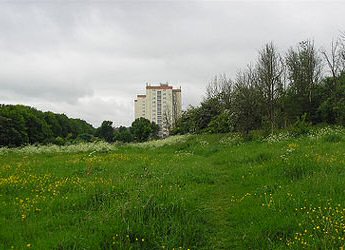The Waulud's Bank Henge
lies on the western edge of the Marsh Farm Estate in
Leagrave, Luton (near to Nev's place). As well as
sitting alongside the prehistoric Icknield Way, and on the St. Michael's Ley,
five springs issue from a basin ten feet deep and a hundred feet wide at the
northern end of the enclosure and these springs form the River Lea
(1)
Archaeological excavations
in 1954 and 1970/71 date the site to around 3,000 B.C. in the Neolithic
period (2),
although there was evidence of earlier Mesolithic hunter/fisher activity in
the immediate area. Grooved ware pottery shards were recovered from the
ditch fill and at ground level under the bank
(3)
The western side of the
enclosure south of the Lea is now occupied by Marsh Farm,
obliterating the ancient features. Interestingly, William
Austin in his 1928 History of Luton records another
bank outside the ditch at this point.
The 'D' shape of the
earthwork is almost identical to that of Marden in Wiltshire, both sites
have a river forming one side, and each produced Neolithic grooved-ware
pottery. The enclosure consisted of a bank and external ditch of
around 7 hectares with a chalk and gravel bank surrounding the source of the
river Lea. No entrances have been identified, although in 1953 it was
hypothesized that it may have been at the northern end where a track enters
the site (1)
The
Council for British Archaeology's Group 9 Newsletter
Number 2 (page 5) of 1972 has a short piece on a recent
excavation of Waulud's Bank prior to construction of a
dual carriageway. The article, again written by James
Dyer, states: "The 1971 excavation confirmed that the
whole earthwork was Neolithic in date. Its ditch, 6 feet
deep and 30 feet wide was flat-bottomed. The material
excavated from it had been piled up to form a bank, the
front of which was revetted with turves. There were no
indications of retaining posts (though one hole was found in 1953).
Sealed below the bank were pieces of Windmill Hill pottery, including a
lug, other decorated Neolithic sherds, a selection of flint work
(including a leaf-shaped arrowhead), and many domestic and wild animal
bones". (1)
Most external features have
been destroyed by medieval ploughing a 19th century
gravel quarry on the south, the building of the Marsh Farm Estate itself (
including dumping tons of chalk and top-soil along the eastern side during
building construction in the 1970s) (2).
Geophysical surveys in June 1970 and January 2009 failed to reveal any very
positive indications of internal features.
The bank still stands 2.6 m
high in places and on the north side the excavated ditch was
9.2 m wide and 2.1 m deep. Finds included Neolithic pottery,
animal bones and flint arrow heads (some of which are on
display at Stockwood Heritage Centre, Luton Museum).
